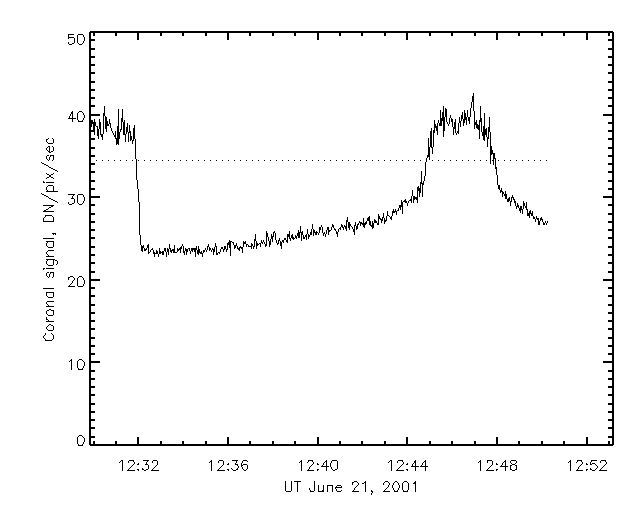Yohkoh had great timing for the eclipses that took place June 21 (also a solstice, of course, making it all the more appropriate that the Moon should execute a "stillstand"). We'll repeat the prediction we made last week, based upon M. Soma's calculations:

Java Script (2 Mbyte) -- MPEG (295 kbyte)
This cunning movie shows that the limb of the Moon hovers just above the limb of the Sun, and moves slowly back and forth across the limb. We have worked out the detailed timing of these phenomena
Using an eclipse as a knife-edge: results
The following movies show the actual event, in close-up detail since we had to sacrifice the full-Sun images to get more data

Java Script (1.1 Mbyte) -- MPEG (177 kbyte) -- GIF (1.1 Mbyte)
More quantitatively, we can plot the signal as a function of time. The timing of the events in the eclipse is the first concern; eventually we will study the rapidity of the eclipse effects to measure or set limits on the extent of photospheric roughness - not a lightweight analysis task, especially because of the low signal-to-noise level.
The plot below simply shows the brightness of the central rows of the images above, but starting much earlier - the initial drop in signal shows the arrival of the Moon over the SXT field of view; the peak later on shows the peek at the corona below the lunar "knife-edge".

In the plot above the dotted line shows the half-signal level, and the times the signal intersects this are roughly 12:45:08 and 12:47:52 UT. These can be compared with the contact times read from the graph in the detailed plot we made of Soma_san's ephemeris. It shows a 10-15 second discrepancy, entirely consistent with the known imprecision of our knowledge of Yohkoh's orbit.
Conclusions
Wheee! We did it! This was one of the trickier observing programs for Yohkoh, rivaling the Mercury transits, and as usual we thank R. Kano, T. Sakao and T. Watanabe in particular for help with hexadecimal commands to the spacecraft, as well as for general counsel. Now we look forward to some serious data analysis. From our present knowledge, we do not expect that the accuracy we'll achieve here will successfully detect an extended solar atmosphere, but the fact that we really don't know, and that this is the very first observation of its kind, means that we will look. Perhaps if TRACE did the same experiment, its superior data flow and angular resolution would lead more easily to a good measurement. It all depends upon celestial mechanics.
June 22, 2001 H. Hudson <hudson@isass1.solar.isas.ac.jp>; D. McKenzie <mckenzie@isass1.solar.isas.ac.jp>; A. Takeda <takeda@isass1.solar.isas.ac.jp>.